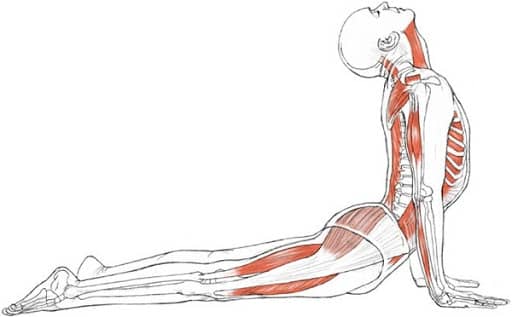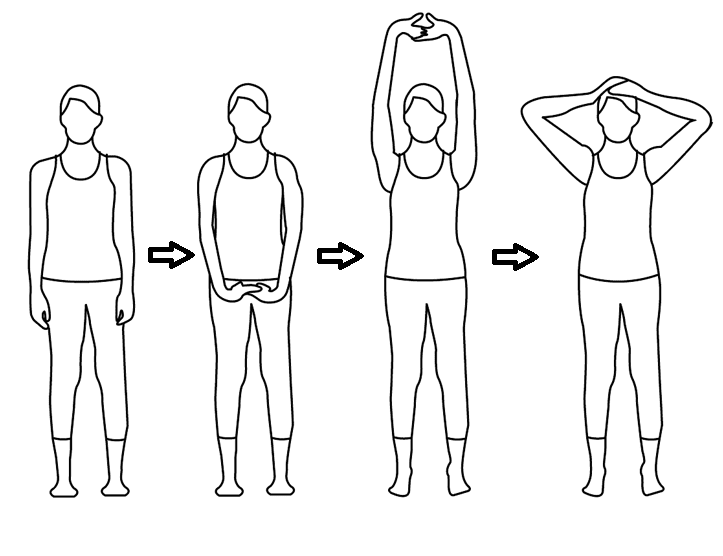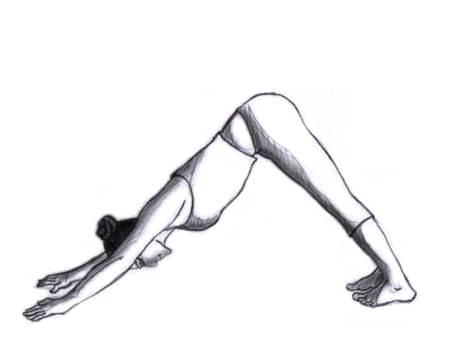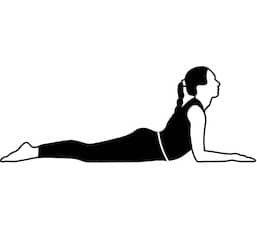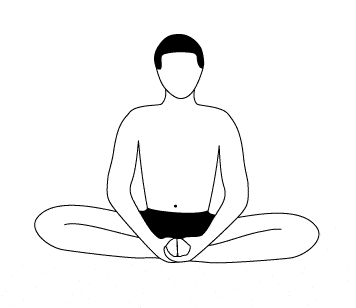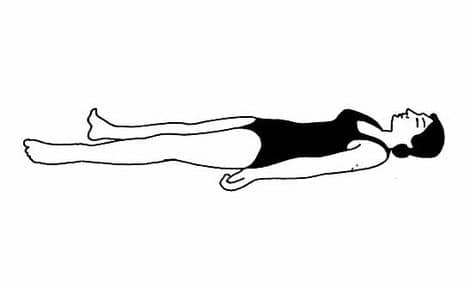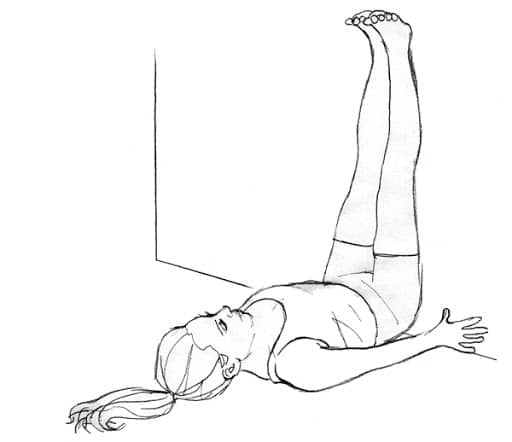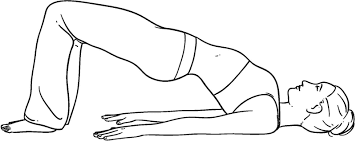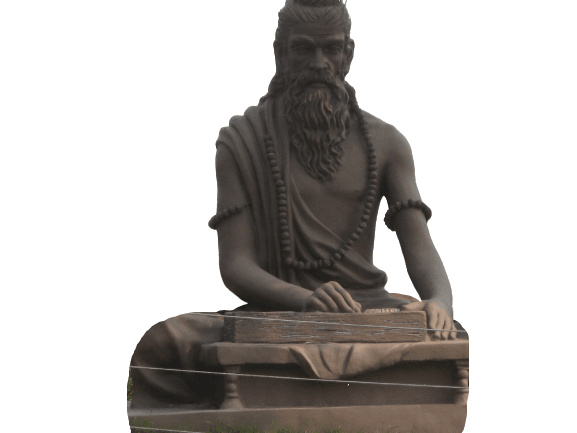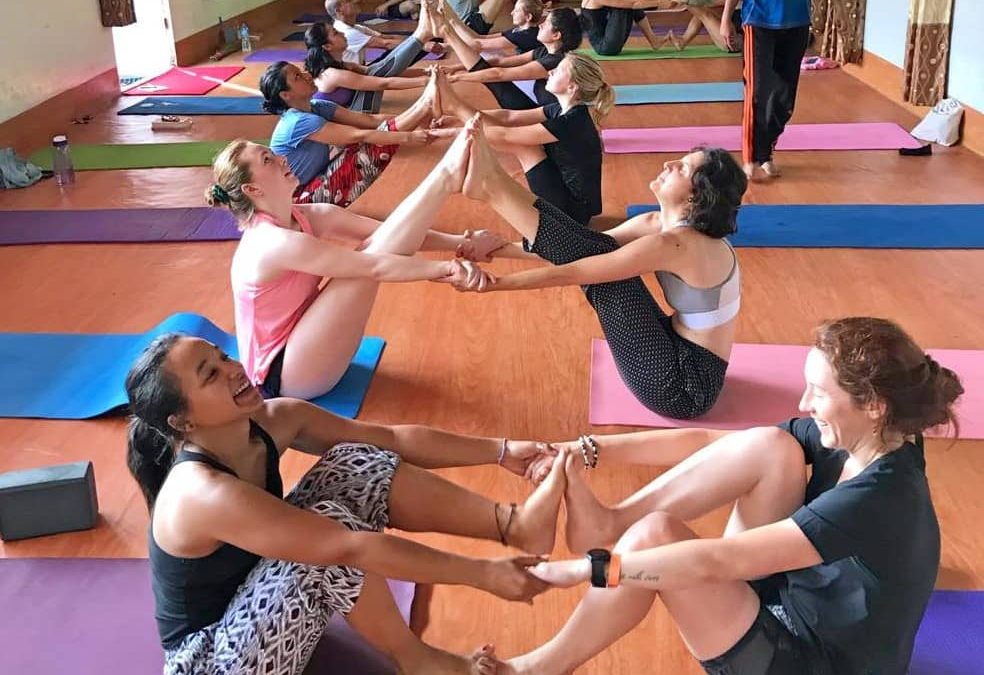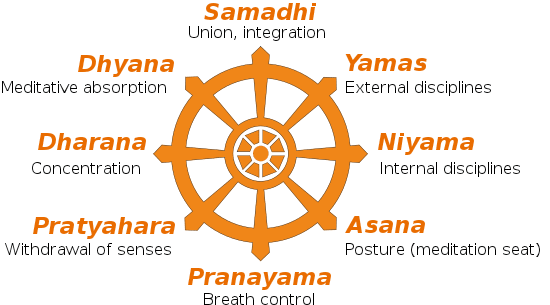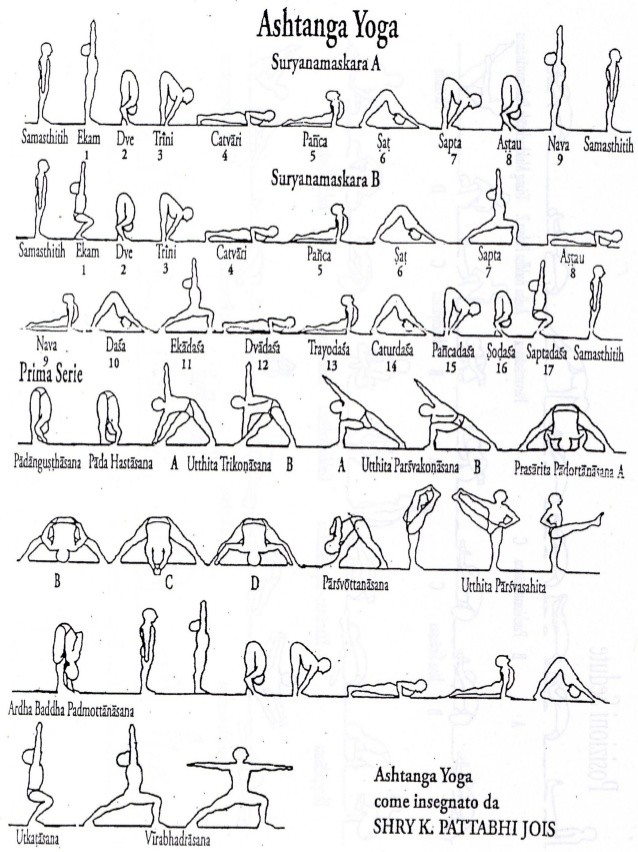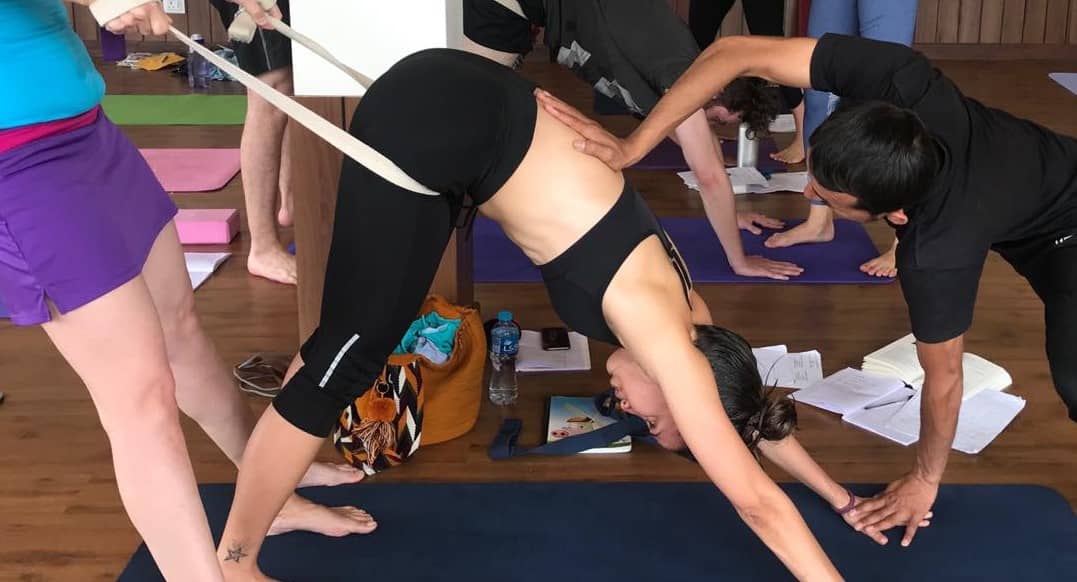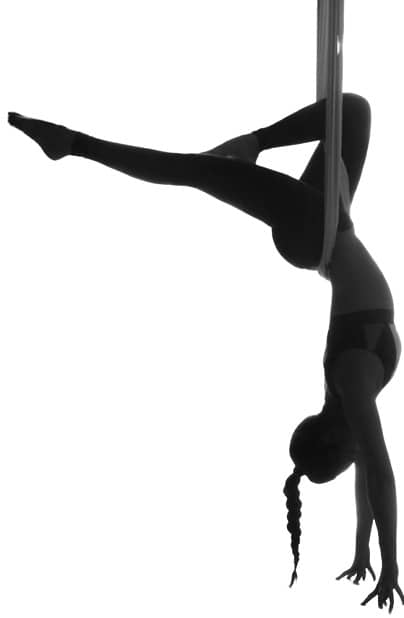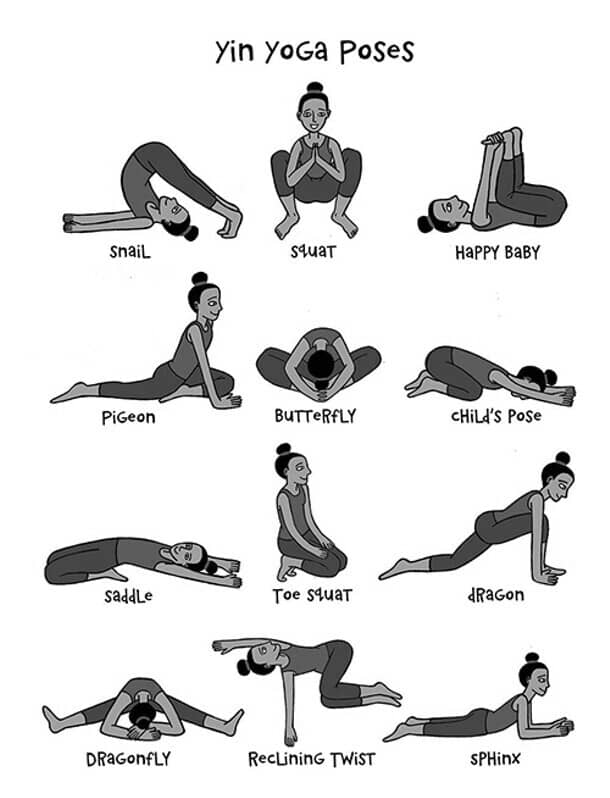
by Yoga In Nepal | Aug 29, 2020 | Yoga
Yoga Anatomy- Introduction
Yoga is not only about poses but also something more than that. It is about undoing what is in the way of the poses. If you are just beginning your journey of yoga or have been in this field for a long time, yoga anatomy will be the invaluable resources for you to perform yoga effectively. Yoga is a composition of 99% practice and 1% theory.
To perform every poses perfectly, we need to gain knowledge of both the practical and theoretical side of yoga. The practice of yoga should be both spiritual and physical, understanding the yoga anatomy will teach us about physical alignment with each muscle that is engaged in asana. This concept of yoga anatomy is often passed by a teacher to a student and is a fundamental part of growing yoga practice in daily life.
To know the Joint effect during the yoga asana, stretching, and contraction of muscles in the human body, Yoga Anatomy is very important. No one can be a good yoga practitioner without knowing the anatomy of yoga. It just gives muscles tear, fractures, and the problem in different parts of the body.
Importance of knowing yoga anatomy
If you want to be a yoga teacher by taking yoga teacher training, you must know about all the yoga anatomies properly. It is very fair for a yoga teacher to ask about the use of “yoga anatomy” in their job. Cause remembering the Latin name of all the muscles and bones is a hard task to do. Multiple reasons point to the value of yoga teachers studying anatomy.
Joint moves in a pose will not be clear if you have no idea about it. You will not be able to tell your students correctly, which part should be contracting, which should be relaxing during a yoga pose. Knowing yoga anatomy, will a cherry on the top because your name as a yoga teacher will be more if you can accurately instruct and explain about poses.
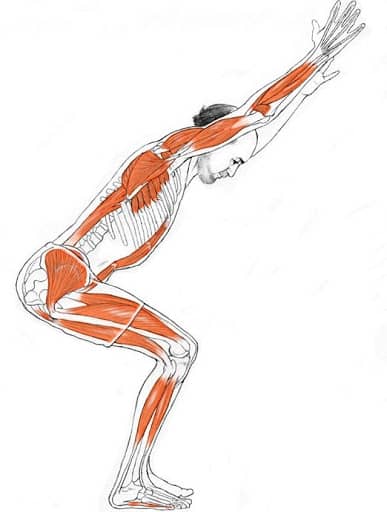
Yoga anatomy—a mysterious place to warm-up?
It is a shed light in a mysterious place to warm-up your weak or injured physical system. If more yoga teachers will be familiar with yoga anatomy, it will be easier to overcome weaknesses and imbalances, recover, and prevent injuries. Knowing anatomical yoga, the yoga teacher will be able to realize the limits and remove barriers of the practitioner.
“Anatomy of Yoga “is a titled book of a reference for yoga teachers or anyone interested in learning more about yoga. The book has cleared all the queries of a yoga teacher about muscles used in each asana. It was written by Dr. Abigail Ellsworth and published in 2013. There are clear instructions and full-colour detailed anatomical drawings. This book depicts the most common asana to provide a deeper understanding of yoga and poses related to it.
Yoga anatomy can benefit anyone and everyone in yoga practice.
It is like having Google Maps for your body. Without yoga anatomy knowledge, you could have just tried yoga, stretching or massaging your buttocks, mistakenly thinking that you have tightness there. When you have a good knowledge of yoga anatomy, then it will help to guide you while you perform any type of yoga poses. It is a smart practice to work on yourself without getting an injury or any chances to be hurt.
After you will get the knowledge of yoga anatomy, you can get a good knowledge of the human system. Therefore, while doing and experimenting with new poses, you can easily know the time to back off. Micromanaging our body and other body as a yoga teacher is a difficult part to do. With proper anatomy knowledge and applying them to our yoga practice, you will know when it is time to slow down for muscle recovery and to avoid injury.
Conclusion
You will also learn to co-activate muscles, contract them, and release them during different yoga poses. This all actions will help us to avoid fatigue, overusing certain muscles, and possible injuries. Yoga anatomy will make us aware of our body and knowledge about its functioning. Practicing yoga without knowledge about yoga anatomy is like driving without a map, driving continuously in the wrong direction, and going nowhere.
The fact is, you will not be a good yoga teacher without Anatomy & You will not be a good yoga practitioner without knowing the yoga anatomy. So, for both teacher and practitioner needs yoga anatomy for proper yoga asana.

by Yoga In Nepal | Aug 25, 2020 | Yoga
10 diseases where yoga works better than allopathy
Yoga is an ancient practice that aims to maintain the equilibrium of the mind and body. There is numerous illness that affects the human body and even after using allopathic means, they remain uncured. In this blog, we shall take a look at the diseases where yoga works better. By practicing yoga, you will be able to mitigate the damage.
1. Back pain
Back pain is one of the most nagging illnesses/problems in the 21st century. Most of our work involves sitting in a chair and as a result, we fall victim to back pain. The discomfort that comes with back pain is probably the most irritating. You might have searched for various remedies on YouTube and online but to no avail. Lucky for you, we have the perfect solution.
If you visit a doctor, he might tell you to practice yoga. The various poses in yoga help to not only relieve the stress accumulated in the back but strengthen them too. Once you follow a proper yoga schedule, you will feel back pain mitigating. It is one of the ailments/diseases where yoga works better.
2. Migraine
The excruciating pain that occurs in migraine is simply unbearable. The sad part is that allopathic medicines are not able to cure it completely. However, with yoga, you can brace your body for the stress it brings. Also, it does not have any drawbacks that most allopathic medicines have like nausea, vomiting, and drowsiness.
The different poses that you can try while battling migraine are as follows:
- Standing forward bend
- Bridge pose
- Child pose
- Cat stretch
- Padmasana
- Shavasana
Once you practice these poses, you’ll understand that it’s one of those diseases where yoga works better.
3. Gastric is a disease where yoga works better than Allopathy
In this modern world where so many of us have unhealthy eating habits, gastric is a huge problem. It occurs due to the inflammation in the stomach lining. Indigestion and stress are the major contributing factors. Likewise, skipping meals and eating untimely also contributes to its growth.
Some allopathic medicines may even cause more side-effects than benefits. For this reason, it is better to use a combination of healthy foods and yoga to combat this ailment. It is also one of the few diseases where yoga works better. The poses that you can use to get relief from gastric are given below:
- Wind relieving pose
- Thunderbolt pose
- Kapalbhati pranayama
- Ustrasana
- Alternate nostril breathing
4. Memory loss
As people grow older, they become vulnerable to various diseases. Among such diseases, memory loss and dementia are major ones. People who suffer from these diseases forget about important and simple events that occurred in their life. Allopathic medicines are still undergoing progression to cure it. To reduce its harm, you can use yoga.
Yoga has the ability to greatly increase your memory power and it helps to fight memory loss. Once you follow a proper yoga program, you will observe that its benefits are simply unmatched. With that in mind, we hope that you join a yoga session soon.
You’ll find more about other diseases where yoga works better.
5. Depression
Stress and Depression is slowly becoming a silent killer in this modern world. It does not discriminate between age and gender. If you are too late, then it will kill you. Various antidepressants are there that reduce its damage but then again there are drawbacks. Some of them include becoming drug dependent. Many doctors advise performing physical exercises and yoga is one of them.
It is also one of the diseases where yoga works better. Some of the poses that you can use to reduce depression and refresh yourself are:
6. Sleep disorder
Sleep disorder or Insomnia is a dangerous disease. People that suffer from it are constantly tired and energyless. Without proper sleep, the body cannot perform its daily functions. Also, insomnia invites other mental ailments like depression, mental disorder, and paranoia. By reading this, you might have understood the importance of a good night’s sleep.
If you want to solve sleep disorder or accentuate your sleeping habits, then practice yoga. Although it might not sound that simple if you go through the poses nicely, then you’ll get the hang of it. It is also a disease where yoga works better than other medicinal practices.
7. Muscle ache
From time to time, we all experience muscle soreness and aches. Most of them occur after performing difficult physical activities. Yoga is a great way to relieve the stress accumulated in the body. Carefully go through the mandatory yoga poses/asanas and find yourself healing at a rapid rate. In addition, you do not need any fancy props or equipment to do it. A simple yoga mat will suffice.
8. Numbness
Numbness and tingling sensation occur when the nerves in the human body are compressed. Throughout the years, numerous allopathic medicines have aimed to cure this disease but to no avail. For this reason, people have switched to yoga as it helps them to keep the pain in the bay. It is also one of those diseases where yoga works better.
Depending on the body part you feel the numbing sensation, you should practice that specific yoga pose. You need to take the help of an instructor for that. Once you start to see the benefits, you’ll realize that yoga has made you physically and mentally well.
9. Blood pressure and diabetes
High blood pressure and diabetes are common household names in modern society. Every house has that one elderly person, who is taking medications for it. To reduce the risk of blood pressure or mitigate its damages, then you need to follow a proper yoga schedule. It is better to start early as it is one of those diseases where yoga works better.
The poses that you can try are as follows:
- Bound angle pose
- Bridge pose
- Heads to knee forward bend
10. Rheumatic problem
Rheumatic problems are cumbersome and are painful too. Allopathic medicine still does not possess all the answers to combat this disease. In that case, look no further than yoga. Practice a series of poses and asanas and find yourself feeling healthier and happier. While deciding to take a yoga session, we advise you to consult a yoga teacher first. It is a disease where yoga works better so you don’t want to have any shortcomings.

by Yoga In Nepal | Aug 24, 2020 | Yoga
10 Poses of Yoga for Elderly People
One best part about yoga is it is so adaptable by all populations with diverse physical and mental abilities. Yoga refreshes our mind and body. It helps to tone our body keeping a harmonic balance between internal systems. However, the popular image of yoga is set for young people but those who are older and less flexible can also practice and enjoy yoga to the fullest.
Elderly people have enough time to practice yoga and many people with hectic schedules only find time after retirement. All types of people can perform most of the yoga poses. However, there are some particular yoga poses made for senior people considering their capacity.
Senior people can do a variety of standing poses, sitting, lying down, and chair yoga asana. As age progress, it is more important to focus on how to do more than what to do are. Yoga is an incredible exercise for the older population to maintain their hormones, bone health, and muscle mass.
Yoga for elderly people will tremendously benefit them providing space for their mind. Yoga for elderly people will help them to forget their sorrows and live a happy life. 10 poses of yoga for elderly people for anti-aging and a healthy lifestyle are listed below:
1. Mountain pose- Yoga for elderly people
Mountain pose is great yoga for elderly people as their postures start to slouch. Stand straight drawing your abdominals in and up relaxing your shoulders down and back. Breathe multiple times engaging your legs muscles. This pose helps to find a balance in our bodies.

2. Tree pose
This pose is excellent for seniors to find balance in them. To practice this pose, you need to stand straight placing one foot on the opposite inner thigh. Open your legs to the side and bring your hands into prayer pose. This pose helps to maintain mobility and reduces hip problems.

3. Downward facing dog
This pose is great for joints, flexibility, and strength. Lift your hips up and back until your body forms a triangle shape. By using your core strength, bring bodyweight back as much as possible. This yoga for the elderly will help seniors with serious wrist problems.

4. Sphinx
It is excellent for people with back pains. Lie down on your stomach placing your arms on ground and elbows under the shoulder. Lift your abdominal in and up and stay at least for eight breathes. It does a great job of opening up chest and heart valves.

5. Cobbler’s pose
It is a great pose of yoga for elderly to open their hips and massage their feet. Sit down folding your legs forward and stretch your back. Hold this position at least five breathes. This helps to generate legs strength and reduces back pain.

6. Savasana
It is the easiest pose on yoga for elderly people. Lie down in a comfortable position relaxing muscles. Take a deep breath lying down and restore energy. This pose helps to reset the nervous system and restores peace in mind.

7. Legs up the wall
Next important pose of yoga for elderly people is Leg up the wall. This pose helps to reduce strain and stress from our minds. Lower your back on the floor shifting your legs up the wall bending your knees slightly if you cannot keep them straight. Breathe deeply and hold this pose for a minute. It helps to recirculate blood back to the heart.

8. Bridge pose
This is great yoga for the lower back. Lie on your back with flat feet, straight arms and hips distance apart directly under your knees. Breathe in and out tightening your stomach. Bridge pose helps to strengthen our hips and lower back. It is also great for thighs.

9. Chair pose – yoga for elderly people
Chair pose helps to improve cardio health. Stand by your feet and swing your hands above your head. Bend your knees to form a right angle with chest and thighs. Hold this pose as much as you can. It helps to improve your balancing skills and strengthen your feet.

10. Low lunge pose
It is one of the best yoga for elderly people. Step your left foot forward and bend your left knee. Lower your right knee to the ground and tuck your back toe under. Breathe for 20-30 seconds in this pose. Low lunge pose helps to stretch your muscles, open your hips, and releases tension from the body.

To know the more depth of yoga, you need to join the yoga teacher training for senior citizens or the related yoga retreat for seniors or seniors yoga. A normal yoga retreat might not be fit where the young people join since old age has its restriction of asana due to flexibility and capability to do it. So, you need to select certain postures, breathing, and meditation techniques to preserve your old age.

by Yoga In Nepal | Aug 21, 2020 | Yoga
Overview
Patanjali is one of the famous among the few world-famous yogis who prevent the yoga for these days. He is an author of the numbers of Sanskrit work (books). He has given a book named Patanjali yoga sutras which is mostly referred book for yoga philosophy. In the yoga tradition, Patanjali is a reversed name. Yoga is a union or merging of mind and soul in the divine element. Yoga is a process of realizing our supreme powers to reach the highest point of spirituality.
To calm yourself and make yourself a powerful person the threefold nature of the person should be developed upon its various lines. Yoga helps us to gain unconditional energy and restore it. According to some people, there were two Patanjali’s, the one known as the commentator upon the grammarian Panini and another about the year 140 B.C.
Patanjali provided The Yoga Sutras
The yoga philosophy of Patanjali is a collection of 196 Sanskrit sutras on the theory. The sutras were compiled around 500 BCE. The yoga philosophy of Patanjali is translated from ancient Indian text. The text fell into relative obscurity for nearly 700 years. Now, it is gaining prominence again in the 20th century.
Yoga history holds the yoga philosophy of Patanjali to be one of the foundational sutras of yoga philosophy. However, some scholars questioned its appropriation and misappropriation. The yoga philosophy of Patanjali incorporated the teaching of many other philosophical systems at that time. Patanjali becomes an inspiration for people to introduce new philosophical things.
Foundation of Yoga Philosophy
Hinduism, Buddhism, and Jainism all the religion influences Patanjali. The yoga philosophy of Patanjali is a foundational text of yoga philosophy school of Hinduism. Thurman writes that Patanjali was influenced by the success of the Buddhist monastic system. It is also believed that the five Yamas of the yoga philosophy of Patanjali bear a resemblance with five vows of Jainism.
So all three religion has a great influence on the foundation of Patanjali.
The philosophy of Patanjali defines yoga as having eight components. The eight limbs of the yogas are Yama (abstinences), niyama (observances), Asana (yoga postures), pranamaya (breath control), pratyahara (withdrawal of senses), Dharana (concentration), dhyana (meditation) and Samadhi (absorption).
Patanjali defines yoga as the restrictions of the fluctuations of consciousness. This practice begins by sitting and calming the fluctuations of our body, breathe, and senses. The yoga philosophy of Patanjali has four chapters. The chapter titled samadhi, sadhana pada, vibhuti pada, and kaivalaya pada respectively. Every chapter of Patanjali discusses the procedures of yoga, its techniques, physic powers, and ultimate liberation.
More description about yoga philosophy of Patanjali
- The first chapter of Patanjali’s yoga sutras is about enlightenment. – samadhi pada.
- The second chapter contains instructions for yoga practice. – sadhana pada.
- The next chapter is all about the progression of our practice. – vibhuti pada.
- The fourth chapter describes supernatural abilities and a shift in perception. – kaivalya.
The yoga philosophy of Patanjali ranks top among the basic philosophical writings of yoga. Patanjali, for of course has gained wide currencies in the centuries before the Common Era. Patanjali’s date can be inferred from the content of its text. There is no accuracy of the date and there are always dissenters against dates. Patanjali is considered the father of yoga as he codified all aspects of yoga into a certain format known as yoga sutras. He explained the epitome of our body, the structure of the body-mind ego, and so on.
Conclusion
The yoga sutras of Patanjali are often countered as the philosophical part of today’s yoga practices. Patanjali has always been a path for the practice of raja yoga, concentration, and meditation. Patanjali begins the treasure for yoga has always influenced people to experiment more about yoga and to attain spirituality.

by Yoga In Nepal | Aug 20, 2020 | Yoga
10 most popular yoga styles
The yoga craze is at an all-time high throughout the world. The number of people practicing yoga either as a hobby or as a means of enlightenment is ever-increasing. In this blog, we shall take a closer look at the popular yoga style that is prevalent and the benefits it provides. Once you go through this blog, you will have an idea regarding which yoga style is suitable for your growth.
1. Hatha yoga- The Most Popular yoga style in the World
Hatha yoga began from Northern India somewhere around 4500 years ago. It was created to prepare the body for meditation and simultaneously, heal the mind. The earliest texts of this divine practice date back to the 15th century which is ‘Hathapradipika’. By practicing Hatha yoga, you can reduce your stress levels, increase flexibility, and tone your body.
To practice this popular yoga style, you need to learn a few poses like sun salutation, asana, and pranayama. The session normally lasts for an hour or two but depending on the level of knowledge you want; it can go beyond that. Also, Hatha yoga incorporates a healthy diet and makes you disciplined.
2. Ashtanga yoga

‘Ashtanga’ means 8 limbs and the term Ashtanga yoga refers to the 8 limbs of yoga. These 8 limbs/disciplines act as a guideline for yoga enthusiasts to achieve their yogic objective. Also, it helps to lead a regulated life. The 8 limbs of yoga are:
- Yama
- Niyama
- Asana
- Pranayama
- Pratyahara
- Dharana
- Dhyana
- Samadhi
While practicing this most popular yoga style, you will take part in a series of postures that are related to one another. The postures are made in such a way that it not only promotes stretching but strengthens the body and allows the energy to flow easily.
3. Ashtanga vinyasa yoga

Ashtanga vinyasa yoga often goes by the name ‘classical Indian yoga’. It was created as a yogic exercise by K. Pattabhi Jois in the 20th century. This yoga style encourages energy flow and synchronizes breath with movements. Each pose is linked with another pose through vinyasa. This yoga highlights major components which are ‘tristhana’ and ‘vinyasa’.
In this yoga session, you need to memorize a sequence of movements. Although the teacher will guide you, it is better that you practice alone. Practicing alone lets you set your own pace and progress accordingly. This most popular yoga style is relatively tiring so do your research before joining it.
4. Iyengar yoga- popular yoga for advanced practice

Iyengar yoga is named after its founder B.K.S. Iyengar, who was born on December 14, 1918. He began practicing yoga after suffering from tuberculosis. The major concept of Iyengar yoga is to do the yoga asanas perfectly. He created the idea that through consistent practice, one can gain mastery over the poses and achieve equilibrium.
Iyengar popularized the use of props like chairs, blocks, and straps. These props are used as assistance in performing asanas. Iyengar yoga is the most popular yoga style but it is everything except easy. In a normal session, expect to stretch for at least a while and you need to devote yourself completely to achieve your objective.
5. Hot yoga – Most popular yoga at high temperature
Under hot yoga, practitioners perform it in a very humid environment. For instance, the temperature of a room in a hot yoga session is more than 30 degrees Celsius. Practicing yoga in such heat results in profuse sweating and some may find it appalling. However, the idea behind this method is to remove the impurities from the body through sweating. So, if you want an experience of a lifetime, then do take this yoga.
6. Aerial yoga

Aerial yoga is a relatively new concept of yoga which is relatively new. It is a revolutionary idea in the field of yoga and is slowly becoming a most popular yoga style. This yoga combines ancient yoga practices and new tools like Pilates. Furthermore, it includes the use of a hammock to perform dances! It may look a bit weird while performing it but it has its benefits.
Performing yoga in a hammock supports the hip and makes arduous mat-based exercises easier to perform. Aerial yoga contributes to psychological, physical, and emotional wellbeing too.
7. Tantra yoga
Tantra yoga is one of the most divine forms of yoga. Lord Shiva created this yoga himself and later, he passed his wisdom to the seven sages called Saptarishi. Throughout the years, tantra yoga has seen changes in postures and asanas but the core idea/belief is the same. The main objective of Tantra is to achieve enlightenment and thus, it is the most popular yoga style.
For practicing Tanta yoga, we need to unify pranayama, asana, mudra, mantra, and chakra control. By unifying all these factors, we can awaken the crucial kundalini energy.
8. Yin yoga-Most popular yoga style in a relaxing way

While the other yoga poses include some form of dynamic stretches, the yin yoga on the contrary is slow. It revolves around the principles of traditional Chinese medicine. In yin yoga, you hold postures for longer durations. The objective of yin yoga is to make the person aware of his inner silence and connect with the superior entity. In recent years, it has found a spot in the list of popular yoga style.
9. Forrest yoga
Forrest yoga dates back to 1982 and Ana T. Forrest was its creator. This yoga style is unique because it emphasizes on holding postures for a longer period. In this yoga, we emphasize the abdomen and also do standing exercises. This yoga is very demanding. It acts as a method to release any physical and emotional trauma. This style is based on four fundamentals which are breath, strength, integrity, and spirit.
10. Power yoga- Most popular yoga style for strength
Power yoga is a relatively new yoga style that focuses on making the body strong and durable. In a power yoga class, you will hear loud music, pumped individuals, probably a humid environment, and plenty of movement. Power yoga is often seen as a cardiovascular exercise and breaks the barrier of ancient yogic traditions. It is quickly becoming the most popular yoga style among the new generation.

by Yoga In Nepal | Aug 16, 2020 | Yoga
Introduction to Aerial Yoga Retreat
In a bid to understand the term ‘Aerial Yoga Retreat’, first, we must understand the fact that a Yoga Retreat is different from a Yoga Holiday. A yoga holiday is a mere vacation with yoga classes available where you might opt to take part in as many as you want.
On the other hand, a retreat has a more specific program schedule built around yoga and you are supposed to participate in most sessions. A yoga retreat is an undisturbed vacation experience that is so much more than just a vacation.
It is a detachment from the hectic and monotonous life. It lets you get started on a wellness journey that aims at the holistic upliftment of the body, mind, and soul through yogic philosophy.
A typical yoga retreat offers a combination of yoga and meditation practice, yogic therapies, mindfulness activities, some retreat includes Ayurveda classes and wholesome foods that complement the yogic lifestyle. Yoga retreats aim at instilling healthy habits in terms of food and other lifestyle choices.
Usually, yoga retreats are located in undisturbed and secluded spots. They help you in digital detoxification and connect you with Nature. Another interesting opportunity that yoga retreats offer is that you get to meet new people from across the world and learn new things, share their take on yoga and wellness.
You also get the chance to visit new places, explore hidden locations, and learn about their rich cultures. Yoga retreats have a wide range. Some keep it simple and stick to the authentic form of yoga practice and wellness, while some others offer a luxurious range of services like spa and massage treatments, custom-made menus on request, adventure activities, etc.
Now, this takes us to the more important topic ‘Aerial Yoga Retreat’. Aerial yoga is a mind-body movement class that uses a fabric hammock, called an aerial yoga hammock, to improve traditional yoga poses. Using the aerial hammock, students are able to explore inversions and aerial acrobatics, skills that help you to increase your upper body strength and achieve proper alignment of your body.
What better way to have fun while trying out a new form of yoga and get that delicious stretching in the hips, shoulders, spine, core, and everything in between. If you have always-wanted flexibility in your life but your rock-hard body fails, you every time, it is time for you to join Aerial Yoga retreat Classes and get what you have always desired.
Importance of Yoga Retreat
A yoga retreat can heal both your mental and physical health. Going on retreat can change your life, and help you to deal with any emotional and mental issues you may be having. It can also be healing for your body if you have experienced an injury.
Furthermore, it helps you to disconnect from the technology and your monotonous life and enables you to connect with nature. It helps you solve problems like overthinking and anxiety. Similarly, it allows you to surround yourself with positive vibes and energy.
Why Aerial Yoga Retreat
Aerial Yoga Retreat can do wonders for you and your body if you follow it with all your heart. The importance of Aerial Yoga Retreat can be best described by dividing it into two different parts – The importance of Yoga Retreat and the Importance of Aerial Yoga.
Importance of Aerial Yoga
Aerial Yoga helps you increase your flexibility and cure your back pain. With aerial yoga, you can perform many inversion poses that you could not earlier. You learn some new body skills when you are suspended against gravity, and your stretches are more effective and non-restrictive.
Not only this, but Aerial yoga also cleanses your system and improves the internal body’s functioning by improving the functioning of the circulatory, respiratory, and digestive systems. When the body’s functions are regulated, the mental abilities are boosted, the mind is relaxed, and the skin is nourished. It is a win-win situation overall.
Prospects in Nepal
Nepal is the place to be especially if you are a yoga enthusiast. By choosing to come here, you will allow yourself to enjoy the sights you will never find anywhere else. Nepal is the ideal location where you can fully and effectively achieve all the benefits of a Yoga Retreat.
Nepal is full of serene and secluded locations and you cannot connect with nature anywhere else as you can do in Nepal. It is a perfect place to switch off from your hectic life and enjoy the heavenly beauty.
In addition, if you are searching for a perfect Aerial Yoga Retreat in Nepal, look no more. We provide 2 hours of Aerial Yoga Classes every day, plus two additional classes in Hatha Yoga and Meditation/Breathing. Moreover, we are well renowned for our fooding and accommodation facilities as well.
We provide the true and living essence of Yoga to our students from around the globe, and we are here to support you in your path. We invite you to participate in this wonderful journey and enjoy the true beauty of Yoga Retreat, here in Nepal.
